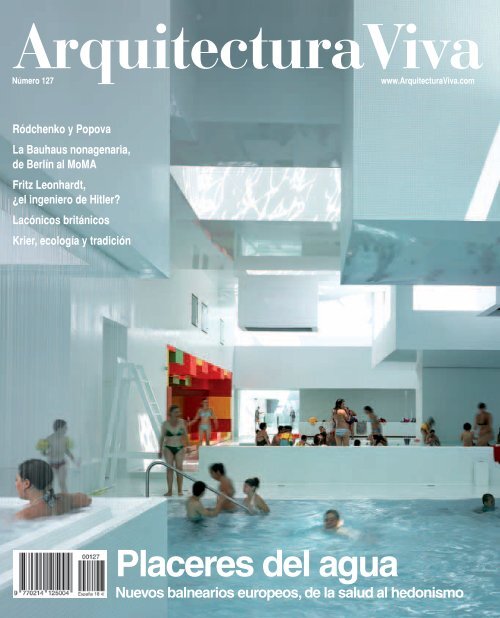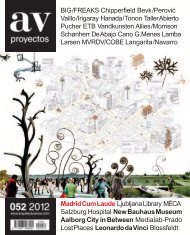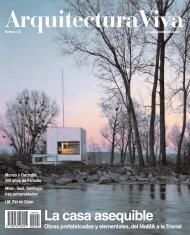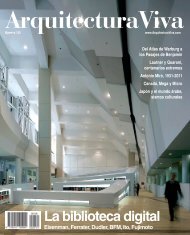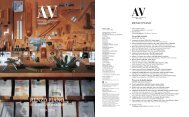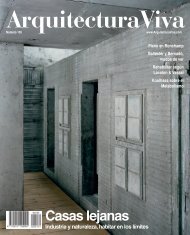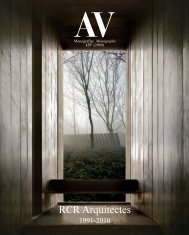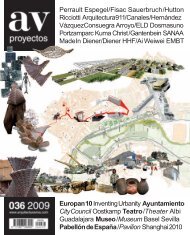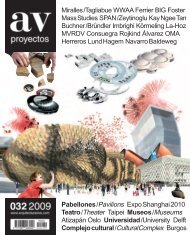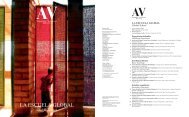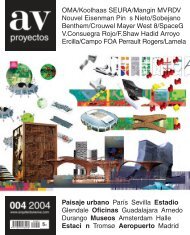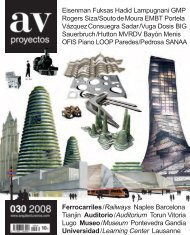Placeres del agua - Arquitectura Viva
Placeres del agua - Arquitectura Viva
Placeres del agua - Arquitectura Viva
You also want an ePaper? Increase the reach of your titles
YUMPU automatically turns print PDFs into web optimized ePapers that Google loves.
<strong>Arquitectura</strong><strong>Viva</strong><br />
Número 127<br />
www.<strong>Arquitectura</strong><strong>Viva</strong>.com<br />
Ródchenko y Popova<br />
La Bauhaus nonagenaria,<br />
de Berlín al MoMA<br />
Fritz Leonhardt,<br />
¿el ingeniero de Hitler?<br />
Lacónicos británicos<br />
Krier, ecología y tradición<br />
<strong>Placeres</strong> <strong>del</strong> <strong>agua</strong><br />
Nuevos balnearios europeos, de la salud al hedonismo
<strong>Arquitectura</strong><strong>Viva</strong><br />
Número 127<br />
Contenido<br />
Sumario<br />
Director<br />
Luis Fernández-Galiano<br />
Director de arte<br />
José Jaime S. Yuste<br />
Diagramación y redacción<br />
Cuca Flores<br />
Beatriz G. Casares<br />
Covadonga Lorenzo<br />
María Cifuentes<br />
Luis Játiva<br />
Beatriz G. Lazo<br />
Leticia Olalquiaga<br />
Raquel Congosto<br />
Coordinación editorial<br />
Laura Mulas<br />
Producción<br />
Laura González<br />
Jesús Pascual<br />
Administración<br />
Francisco Soler<br />
Suscripciones<br />
Lola González<br />
Distribución<br />
Mar Rodríguez<br />
Raquel Vázquez<br />
Publicidad<br />
Susana Blanco<br />
Cecilia Rodríguez<br />
Redacción y administración<br />
<strong>Arquitectura</strong> <strong>Viva</strong> SL<br />
Aniceto Marinas, 32<br />
E-28008 Madrid<br />
Tel: (+34) 915 487 317<br />
Fax: (+34) 915 488 191<br />
AV@<strong>Arquitectura</strong><strong>Viva</strong>.com<br />
www.<strong>Arquitectura</strong><strong>Viva</strong>.com<br />
Precio: 18 euros<br />
© <strong>Arquitectura</strong> <strong>Viva</strong><br />
<strong>Arquitectura</strong> <strong>Viva</strong> es miembro de ARCE<br />
Todos los derechos reservados All rights reserved<br />
Esta revista ha recibido una ayuda de la Dirección<br />
General <strong>del</strong> Libro, Archivos y Bibliotecas <strong>del</strong><br />
Ministerio de Cultura para su difusión en bibliotecas,<br />
centros culturales y universidades de España para la<br />
totalidad de los números <strong>del</strong> año.<br />
Depósito legal: M. 17.043/1988<br />
ISSN: 0214-1256<br />
Distribución en quioscos<br />
Coedis, www.coedis.com<br />
Cubierta: Jean Nouvel, Les Bains des Docks<br />
en Le Havre, Francia. Foto: Philippe Ruault<br />
Traducción: L. Krier (M. Cifuentes),<br />
E. Domínguez Uceta (L. Mulas)<br />
Fe de errores: Brasil albergará en 2016 los primeros<br />
Juegos Olímpicos celebrados en Suramérica, no en<br />
Latinoamérica, como apareció en la p.5 <strong>del</strong> número<br />
126. En 1968 los JJOO tuvieron lugar en México.<br />
Los placeres <strong>del</strong> <strong>agua</strong>. Fuente de vida y símbolo de limpieza, el <strong>agua</strong> está<br />
unida a la arquitectura desde su origen: las ciudades surgen donde aquélla abunda.<br />
Desde antiguo se han conocido las propiedades de las <strong>agua</strong>s minerales, las<br />
virtudes tonificantes de alternarla a distintas temperaturas y las relajantes <strong>del</strong><br />
vapor. En Occidente los romanos inventaron las termas, heredadas vía Bizancio<br />
por el Islam y convertidas en hamams; entre los siglos XV y XVIII decayó la<br />
costumbre <strong>del</strong> baño; la Ilustración ensalzó la higiene y la burguesía ociosa puso<br />
de moda los balnearios; hoy buscamos sumergirnos en sensaciones únicas.<br />
Tema de portada<br />
Bañistas contemporáneos. En tiempos de culto al cuerpo y estrés generalizado,<br />
los establecimientos de baño se han convertido en lugares donde<br />
ser y ser vistos en los que se unen sensualidad y terapias, diversión y cuidados.<br />
Un recorrido por seis países de Europa nos traslada de las cúbicas piscinas<br />
municipales en la costa normanda a las termas cristalizadas junto a un manantial<br />
en uso desde la época de Tiberio en el Pirineo de Huesca, el lujoso centro<br />
de tratamientos incrustado en una ladera de los Grisones suizos, las piscinas<br />
públicas al aire libre elevadas sobre una plataforma bajo la que se despliega un<br />
acuario de hormigón en el Tirol italiano, y el balneario a base de cúpulas<br />
sobresaliendo de una nave climatizada al pie de los Alpes bávaros, finalizando<br />
en el sanatorio camuflado en un bosque en la Estiria austriaca.<br />
Argumentos y reseñas<br />
Vidas de vanguardia. Las trayectorias artísticas de Ródchenko y Popova<br />
se exponen en el Reina Sofía de Madrid, y los noventa años de la Bauhaus se<br />
celebran en el Martin Gropius Bau de Berlín y el MoMA de Nueva York.<br />
Centenarios paralelos. Ernesto Rogers y Fritz Leonhardt nacieron en 1909<br />
y vivieron el totalitarismo desde lados opuestos. Tras la guerra, el italiano se<br />
dedicó a BBPR y dirigió Casabella; el alemán construyó obras ejemplares.<br />
Ecología y tradición. Más de tres décadas después de la crisis <strong>del</strong> petróleo,<br />
las advertencias de Léon Krier ganan vigencia; dos volúmenes recientes<br />
recopilan sus textos y dibujos. Además, Utzon, Piano y libros recibidos.<br />
Últimos proyectos<br />
Lacónicos británicos. A mediados de los noventa, como relata Vassallo,<br />
un grupo de jóvenes arquitectos ingleses se reunían en la casa Sudgen de los<br />
Smithson con el fin de establecer una posición crítica respecto a la arquitectura<br />
comercial y el ultraliberalismo <strong>del</strong> momento. Tres lustros después, el azar<br />
hace coincidir la inauguración de las obras de tres de ellos: un pequeño museo<br />
danés de Fretton, un centro de arte de inspiración industrial de Caruso y<br />
St. John, y un conjunto de talleres para artesanos de Sergison y Bates; a ellos<br />
se une con similar lenguaje despojado y realista un centro de arte con teatro<br />
firmado por el también británico Terry Pawson, que no perteneció al grupo.<br />
Para terminar, el polémico Léon Krier reivindica con argumentos energéticos<br />
la ciudad tradicional frente a la oportunista apuesta por la sostenibilidad.<br />
22 Enrique Domínguez Uceta<br />
España balnearia<br />
De las termas a los spas urbanos<br />
25 Justo Isasi<br />
Con el <strong>agua</strong> al cuello<br />
Seis apuntes de la vida húmeda<br />
28 Andrés Jaque<br />
Chapuzones colectivos<br />
Tres arquitecturas acuáticas<br />
<strong>Arquitectura</strong><br />
32 Jean Nouvel<br />
Centro acuático, Le Havre<br />
38 Moneo y Brock<br />
Termas de Tiberio, Panticosa<br />
44 Mario Botta<br />
Spa Bergoase, Arosa<br />
48 The next ENTERprise<br />
Piscinas, Caldaro<br />
52 Behnisch Architekten<br />
Baños termales, Bad Aiblig<br />
56 Jensen y Skodvin<br />
Balneario, Bad Gleichenberg<br />
Arte / Cultura<br />
62 Ginés Garrido<br />
Vidas cruzadas<br />
64 María Ocón<br />
El taller de la modernidad<br />
68 Eugenia López Reus<br />
Teoría en acción<br />
70 Luis Fernández-Galiano<br />
¿El ingeniero de Hitler?<br />
72 Historietas de Focho<br />
Torres y minaretes<br />
73 Autores varios<br />
Libros<br />
Técnica / Diseño<br />
80 Jesús Vassallo<br />
La épica de lo cotidiano<br />
84 Tony Fretton<br />
Museo de Arte Fuglsang, Toreby<br />
88 Caruso y St. John<br />
Centro de Arte, Nottingham<br />
92 Sergison y Bates<br />
Centro de Artesanía, Ruthin<br />
96 Terry Pawson<br />
Teatro y Centro de Arte, Carlow<br />
112 Léon Krier<br />
La modernidad insostenible
Contents<br />
Synopses<br />
22 Enrique Domínguez Uceta<br />
Thermal Spain<br />
From Baths to Urban Spas<br />
25 Justo Isasi<br />
Deep in Water<br />
Six Notes on Humid Life<br />
28 Andrés Jaque<br />
Collective Splashes<br />
Three Aquatic Architectures<br />
Architecture<br />
32 Jean Nouvel<br />
Aquatic Center, Le Havre<br />
38 Moneo & Brock<br />
Tiberius Baths, Panticosa<br />
44 Mario Botta<br />
Bergoase Spa, Arosa<br />
48 The next ENTERprise<br />
Swimming Pools, Caldaro<br />
52 Behnisch Architekten<br />
Thermal Baths, Bad Aiblig<br />
56 Jensen & Skodvin<br />
Spa, Bad Gleichenberg<br />
Art / Culture<br />
62 Ginés Garrido<br />
Vital Crossings<br />
64 María Ocón<br />
The Workshop of Modernity<br />
68 Eugenia López Reus<br />
Theory in Action<br />
70 Luis Fernández-Galiano<br />
Hitler’s Engineer?<br />
72 Focho’s Cartoon<br />
Towers and Minarets<br />
73 Various Authors<br />
Books<br />
Technique / Design<br />
80 Jesús Vassallo<br />
The Epic of the Everyday<br />
84 Tony Fretton<br />
Fuglsang Art Museum, Toreby<br />
88 Caruso & St. John<br />
Art Center, Nottingham<br />
92 Sergison & Bates<br />
Craft Center, Ruthin<br />
96 Terry Pawson<br />
Theater and Art Center, Carlow<br />
112 Léon Krier<br />
Unsustainable Modernity<br />
The Pleasures of Water. Fountain of life and symbol of cleanliness, water<br />
is linked to architecture since its origin: cities spring where water flows. Its<br />
mineral qualities are well known since ancient times, the invigorating virtues of<br />
alternating it at different temperatures and the relaxing ones of steam. In the West<br />
the Romans invented thermal baths, inherited via Byzantium by Islam in the<br />
form of hammams; the custom of bathing waned between the 15th and 18th centuries;<br />
the Enlightenment praised hygiene and the bourgeoisie turned spas into<br />
fashionable places; today we seek submerging ourselves in unique sensations.<br />
Cover Story<br />
Contemporary Bathers. In these times of cult of the body and widespread<br />
stress, thermal bath facilities have become places for socialization, bringing<br />
together sensuality and therapy, entertainment and care. A journey through<br />
six European countries takes us from the cubic municipal swimming pools of<br />
the coasts of Normandy to the spa built by a spring which was already in use<br />
in times of Tiberius in the Pyrenees of Huesca, the luxurious therapy center<br />
tucked into a hillside in the Swiss Grisons, the public outdoor pools atop a<br />
platform that stretches over an aquarium of concrete in the Italian Tyrol area,<br />
and the thermal bath complex consisting of domes projecting from a heated<br />
hall at the foot of the Bavarian Alpes, ending at the life medicine resort<br />
camouflaged in the woods of the Austrian Styria region.<br />
Views and Reviews<br />
Avant-Garde Lives. The Reina Sofía Museum of Madrid covers the artistic<br />
careers of Ródchenko and Popova, and the Martin Gropius Bau of Berlin<br />
and the MoMA of New York celebrate the ninetieth anniversary of the Bauhaus.<br />
Parallel Centennials. Ernesto Rogers and Fritz Leonhardt were both born<br />
in 1909, and experienced totalitarianism from opposite sides. After the war, the<br />
Italian joined BBPR and edited Casabella; the German built noteworthy works.<br />
Ecology and Tradition. More than three decades after the oil crisis, the<br />
warnings of Léon Krier gain relevance; two recently published volumes collect<br />
his writings and drawings. Piano, Utzon and books received close the section.<br />
Recent Projects<br />
Laconic Brits. In the mid-nineties, as Vassallo describes, a group of young<br />
English architects gathered at the Sudgen House of the Smithsons with the aim<br />
of defining a critical stance regarding the commercial architecture and the ultraliberalism<br />
of the time. Fifteen years later, chance has decreed that the works<br />
of three of them be inaugurated at the same time: the small Danish museum by<br />
Fretton, an art center of industrial character by Caruso & St. John, and a series<br />
of arts and crafts workshops by Sergison & Bates; the section is rounded off<br />
with an art center and theater that displays a similarly bare and realistic language,<br />
and that was designed by Terry Pawson, not a member of the group.<br />
To close, the polemical Léon Krier uses forceful arguments in favor of the<br />
traditional city in times of opportunist commitment to sustainability.
<strong>Placeres</strong> <strong>del</strong> <strong>agua</strong><br />
Si antaño fue salud o limpieza, hoy el baño es placer. El historiador de la<br />
técnica Sigfried Giedion describió la evolución histórica <strong>del</strong> baño entre los<br />
dos polos <strong>del</strong> rejuvenecimiento y la higiene: bien como instrumento de<br />
rehabilitación corporal, bien como medio de limpieza personal. La inmersión<br />
en <strong>agua</strong> caliente o fría servía para regenerar los cuerpos maltratados por la<br />
enfermedad o por la edad, y también para lavar la piel o el pelo de la suciedad<br />
adherida por la vida diaria. El descubrimiento de los gérmenes reunió ambas<br />
funciones, y desde entonces la salud y la higiene son inseparables, haz y<br />
envés <strong>del</strong> baño regular. Sin embargo, hoy ponemos la salud en manos de la<br />
medicina científica, y encomendamos la higiene diaria a la somera ducha<br />
—inicialmente concebida como una mecanización <strong>del</strong> lavado desarrollada en<br />
el contexto colectivo de los cuarteles—, mientras el baño queda reservado al<br />
placer sensual <strong>del</strong> hedonismo ensimismado.<br />
La revolución moderna de la fontanería, que transformó los muebles y<br />
recipientes <strong>del</strong> aseo en aparatos sanitarios incorporados a las fábricas de los<br />
inmuebles, hizo <strong>del</strong> baño episódico una práctica frecuente, y generalizó en el<br />
ámbito doméstico lo que hasta aquel momento tenía como marco las termas<br />
o los baños públicos, fragmentando así en recintos individuales o familiares<br />
la tradicional naturaleza social y comunitaria de los espacios <strong>del</strong> <strong>agua</strong>.<br />
Este enclaustramiento y privatización de la inmersión salutífera fue haciendo<br />
perder importancia tanto a las casas de baños urbanos como a los balnearios<br />
vinculados a manantiales termales, recintos de sociabilidad espontánea que<br />
acabaron asociados a minorías específicas o a sectores envejecidos de la<br />
población. Pero actualmente asistimos a un auge de los spas ciudadanos y de<br />
las termas en entornos naturales que se dirigen a un público nuevo, orientado<br />
al bienestar y al consumo de experiencias.<br />
Si la contemporánea recuperación de las vetustas instalaciones termales,<br />
segregadas cada vez más de las virtudes terapéuticas de ‘tomar las <strong>agua</strong>s’,<br />
supone un bienvenido rescate <strong>del</strong> baño para el dominio colectivo, al mismo<br />
tiempo es un índice de la extensión <strong>del</strong> culto al cuerpo en nuestras sociedades<br />
opulentas. Este hedonismo saludable, que deja atrás épocas de negación y<br />
represión, es a la vez una señal de dorada decadencia, y también un signo de<br />
la prosperidad ociosa de Occidente, que contrasta con las carencias higiénicas<br />
y sanitarias de tantas zonas desvalidas de un mundo en cuyo horizonte se<br />
dibujan ya las nuevas guerras <strong>del</strong> <strong>agua</strong>. Estos conflictos, abreviados de forma<br />
paródica en nuestras tristes pugnas regionales por las cuencas hidrográficas,<br />
recuerdan la escasez y desigualdad en el acceso que in<strong>del</strong>eblemente marca la<br />
biopolítica global <strong>del</strong> <strong>agua</strong>, cuyos indudables placeres no pueden hacernos<br />
ignorar nuestro no menos evidente privilegio.<br />
Luis Fernández-Galiano<br />
If yesteryear bathing meant health and cleanliness,<br />
today it means pleasure. The historian of technique<br />
Sigfried Giedion described the historical evolution<br />
of the bath between the two poles of rejuvenation<br />
and hygiene: either as a means to regenerate the<br />
human body, or as a device for personal grooming.<br />
The immersion in hot or cold water served to restore<br />
bodies worn out by disease or age, and was also<br />
used to remove everyday dirt from the skin or hair.<br />
The discovery of germs united both functions, and<br />
health and hygiene have since become inseparable,<br />
as the twin purposes of regular bathing. However,<br />
today we put our health in the hands of medicine,<br />
and entrust daily hygiene to the perfunctory shower<br />
– initially conceived as a mechanization of washing<br />
developed in the collective context of barracks –,<br />
whereas the bath is reserved to the sensual pleasures<br />
of self-absorbed hedonism.<br />
The modern plumbing revolution, which replaced<br />
the washing furniture of bowls and jars with sanitary<br />
fittings, turned episodic bathing into a frequent<br />
practice, and generalized in the domestic realm what<br />
until then had taken place in thermal or public baths,<br />
thus fragmenting in individual or familiar precincts<br />
the social or communal nature of the spaces of water.<br />
This gradual cloistering and privatization of healthy<br />
immersion increasingly diminished the importance<br />
both of the urban bathhouses and of spas linked to<br />
thermal springs, spaces of spontaneous socialization<br />
that ended up being associated to specific minorities<br />
or to older sectors of the population. But currently<br />
we are witnessing a boom of urban spas and thermal<br />
baths in natural environments that are addressed to<br />
a new public, eager to pursue well-being and also in<br />
permanent search of experiences, understood as a<br />
new form of consumption.<br />
If the contemporary refurbishment of traditional<br />
thermal facilities, these days no longer based on the<br />
therapeutical virtues of ‘taking the waters’, entails a<br />
welcomed rescue of the bath for the collective realm,<br />
it is at the same time a sign of the extension of the<br />
cult of the body in our opulent societies. This healthy<br />
hedonism, which leaves behind ages of negation and<br />
repression, is at the same time a reflection of golden<br />
decadence, and also a mark of the prosperity and<br />
leisure of the West, which contrasts with the hygienic<br />
and sanitary shortages in many destitute regions of<br />
a world whose horizons already herald the new<br />
water wars. These conflicts, parodically summarized<br />
in Spain’s sad regional struggles over the river<br />
basins, recall the scarcity and the unequal access to<br />
this vital resource that in<strong>del</strong>ibly mark the global<br />
biopolitics of water, whose undeniable pleasures<br />
cannot make us forget our no less evident privilege.


